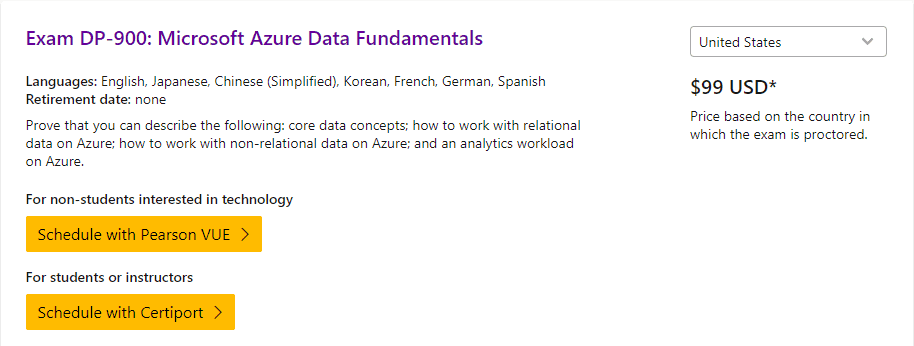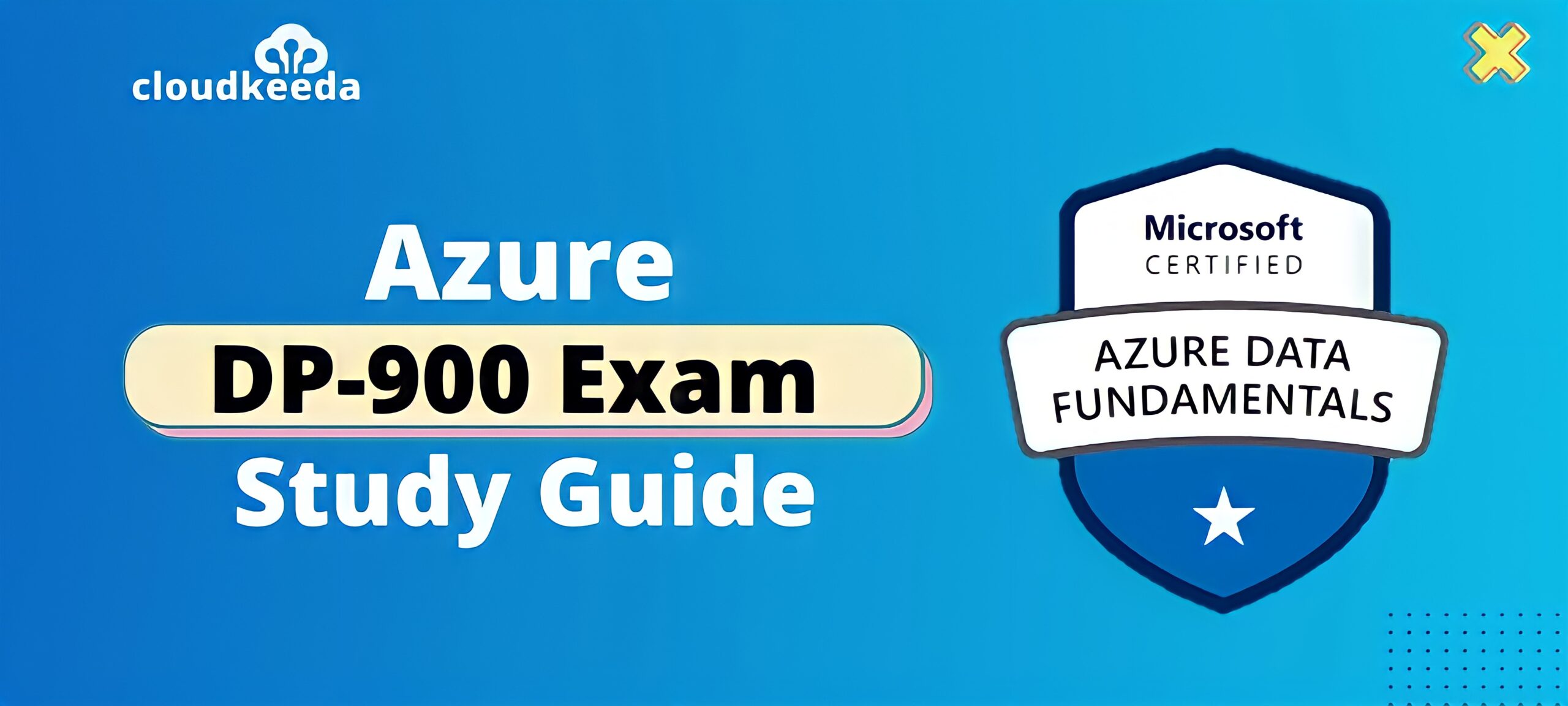The DP-900 Microsoft Azure Data Fundamentals Certification is for the applicants who need to begin working with information on the cloud, get essential abilities in cloud information administrations, and construct primary information on cloud information administrations in Microsoft Azure.
In the realm of information, the DP 900 is the absolute first trial of a data expert, data set director, or data specialist’s abilities in posing, and addressing the important inquiries about moving, putting away information, and effectively utilizing it.
The topics covered in this blog are:
- What is Azure Data Fundamentals Certification?
- Who Can Do This Certification?
- Benefits of DP-900 Certification
- DP-900 Exam Details
- Exam DP-900 Skills Measured
- How to Register for Azure DP 900 Exam
- Pre-requisites for DP-900 Certification
- Azure Data Fundamentals Certification (DP 900) Study Guide
- DP 900 Exam Retake Policy
- DP 900 Exam Day Tips
- Conclusion
- FAQs
What is Azure Data Fundamentals Certification?
The DP-900 Microsoft Azure Data Fundamentals Certification is for the aspirants who need to start operating with data on the cloud, get fundamental capacities in cloud data organizations, and develop essential data on cloud data organizations in Microsoft Azure.

Are you a beginner in the Azure cloud? Do check out our blog post on the Azure Certification Path and choose the best certification for you.
Unlock your full potential for the DP-900: Microsoft Azure Data Fundamentals Exam Practice Test with our recommended practice test. Enroll Now and gain an edge over the competition!
Who Can Do This Certification?
You will be anxious to know whether you are the right contender for this certificate! Here is the solution to that:
- Aspirants who are keen on working with Data and Data Solutions.
- Information experts, Data planners, and Business insight experts need to find out about the information stage advancements existing on Microsoft Azure.
- Those operating as Data Engineers.
- Applicants who design and execute Cloud Solutions.
- Application Developers for conveying content from the information stage innovations that exist on Microsoft Azure.
Benefits of DP-900 (Azure Data Fundamentals) Certification
- This certification will supply an extensive perception into how you may paint with information at the cloud and validate your useful expertise of cloud information inside Microsoft Azure Services.
- After clearing this certification, you may propose different Azure role-primarily based totally certifications including Azure Database Administrator Associate or Azure Data Engineer Associate.
- There is a big call for folks who can paint with information and use Microsoft Azure Services with inside the enterprise today, CV with this sparkling certification holds a terrific
- In phrases of income and task prospects, a certification results in a rampant increment in both.
- Updating your expert profile with certificates like this will increase the opportunity of having recruited and additionally elevates your task
Also Check: Azure Data Factory Interview Questions
DP-900 Exam Details
Exam Name Exam DP-900: Microsoft Azure Data Fundamentals | Exam Duration 90 Minutes |
Exam Type Multiple Choice Examination | Number of Questions 40 - 60 Questions |
Exam Fee $99 | Eligibility/Pre-Requisite None |
Exam validity Lifetime | Exam Languages English, Japanese, Korean, and Simplified Chinese |
Exam DP-900 Skills Measured
Core data concepts | 15-20% |
How to work with relational data on Azure | 25-30% |
How to work with non-relational data on Azure | 25-30% |
Analytics workload on Azure | 25-30% |
How to Register for Azure DP-900 Exam
You can register for Microsoft Azure Data Fundamentals Exam (DP 900) by going to the official Microsoft page.

Pre-requisites for DP-900 Certification
There are no pre-requisites for the DP-900 exam.
Azure Data Fundamentals Certification (DP 900) Study Guide
Describe core data concepts (15-20%)
Describe types of core data workloads
- describe batch data
- describe streaming data
- describe the difference between batch and streaming data
- describe the characteristics of relational data
Describe data analytics core concepts
- describe data visualization (e.g., visualization, reporting, business intelligence (BI))
- describe basic chart types such as bar charts and pie charts
- describe analytics techniques (e.g., descriptive, diagnostic, predictive, prescriptive, cognitive)
- describe ELT and ETL processing
- describe the concepts of data processing
Describe how to work with relational data on Azure (25-30%)
Describe relational data workloads
- identify the right data offering for a relational workload
- describe relational data structures (e.g., tables, index, views)
Describe relational Azure data services
- describe and compare PaaS, IaaS, and SaaS solutions
- describe Azure SQL family of products including Azure SQL Database, Azure SQL Managed Instance, and SQL Server on Azure Virtual Machines
Identify basic management tasks for relational data
- describe provisioning and deployment of relational data services
- describe method for deployment including the Azure portal, Azure Resource Manager templates, Azure PowerShell, and the Azure command-line interface (CLI)
- identify data security components (e.g., firewall, authentication)
- identify basic connectivity issues (e.g., accessing from on-premises, access from Azure VNets, access from Internet, authentication, firewalls)
- identify query tools (e.g., Azure Data Studio, SQL Server Management Studio, sqlcmd utility, etc.)
Describe query techniques for data using SQL language
- compare Data Definition Language (DDL) versus Data Manipulation Language (DML)
- query relational data in Azure SQL Database, Azure Database for PostgreSQL, and Azure Database for MySQL
Describe how to work with non-relational data on Azure (25-30%)
Describe non-relational data workloads
- describe the characteristics of non-relational data
- describe the types of non-relational data
- recommend the correct datastore
- determine when to use non-relational data
Describe non-relational data offerings on Azure
- identify Azure data services for non-relational workloads
- describe Azure Cosmos DB APIs
- describe Azure Table storage
- describe Azure Blob storage
- describe Azure File storage
Identify basic management tasks for non-relational data
- describe provisioning and deployment of non-relational data services
- describe method for deployment including the Azure portal, Azure Resource Manager templates, Azure PowerShell, and the Azure command-line interface (CLI)
- identify data security components (e.g., firewall, authentication, encryption)
- identify basic connectivity issues (e.g., accessing from on-premises, access from Azure VNets, access from Internet, authentication, firewalls)
- identify management tools for non-relational data
Describe an analytics workload on Azure (25-30%)
Describe analytics workloads
- describe transactional workloads
- describe the difference between a transactional and an analytics workload
- describe the difference between batch and real-time
- describe data warehousing workloads
- determine when a data warehouse solution is needed
Describe the components of a modern data warehouse
- describe Azure data services for modern data warehousing such as Azure Data Lake Storage Gen2, Azure Synapse Analytics, Azure Databricks, and Azure HDInsight
- describe modern data warehousing architecture and workload
Describe data ingestion and processing on Azure
- describe common practices for data loading
- describe the components of Azure Data Factory (e.g., pipeline, activities, etc.)
- describe data processing options (e.g., Azure HDInsight, Azure Databricks, Azure Synapse Analytics, Azure Data Factory)
Describe data visualization in Microsoft Power BI
- describe the role of paginated reporting
- describe the role of interactive reports
- describe the role of dashboards
- describe the workflow in Power BI
DP 900 Exam Retake Policy
- If a candidate isn’t capable of clearing their first try, they must wait for twenty-four hours earlier than they are trying again.
- In case the candidate does now no longer clear the 2nd try also, he/she ought to re-get right of entry to their education and retake the examination after a ready duration of 14 days.
- At last, a candidate has a most of five retakes allowed in a year.
DP 900 Exam Day Tips
- Run a System Test earlier than the examination.
- Keep the work station clean, because the proctor will reveal the environment through the webcam.
- Do not keep any digital gadgets around you.
- No breaks can be allowed throughout the examination for any reason.
- There may be a version within side the examination query kinds including fill within side the blanks, actual or false, a couple of answers, a couple of of-choice, drag-and-drop, fill the lacking modules within side the given pipeline, so be equipped for it!
- Last but the most crucial Time Management, be cautious and tempo yourself at the questions in order now no longer to get caught on one query for extremely long.
Conclusion
In this Azure tutorial, we discussed What is Azure Data Fundamentals Certification, Who Can Do This Certification, benefits, Exam Details, Study Guide, and much more.
I hope you have enjoyed this article!!!
FAQs
Q1. Who should take DP-900?
Data analysts, data engineers, database administrators, and Microsoft app developers should take DP-900.
Q2. How long is dp900 valid?
The Microsoft Azure Data Fundamentals Certification (DP-900) is valid for one year from the date you pass the exam. After one year, your certification will expire and you will need to renew it in order to continue to demonstrate your knowledge and skills in Azure.
Q3. How long is the DP-900 exam?
DP-900 exam is 90 minutes long.
Q4. How many questions are on the DP900 exam?
The Microsoft DP-900 exam has 40-60 questions.
Q5. What is passing score for DP 900?
The pass mark for the Microsoft Azure Data Fundamentals Certification (DP-900) exam is 700 out of 1000 points.
Q6. How much does DP 900 cost?
The DP-900 exam costs $99 USD.
Q7. Is Microsoft DP-900 worth IT?
Yes, Microsoft DP-900 is worth it if you are interested in gaining knowledge and skills in the field of data management and cloud computing using Microsoft Azure.

